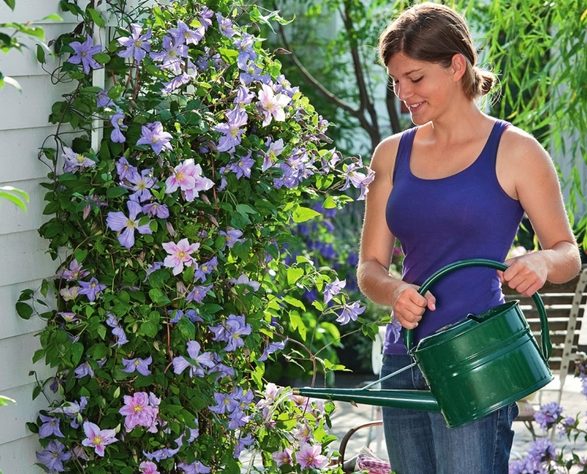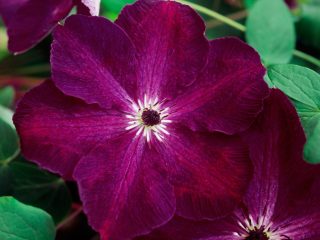Content
Clematis Pink Fantasy was developed in Canada. Its originator is Jim Fisk. In 1975, the variety was registered in the State Register, American and Canadian gardeners began to grow it, and soon it became popular in other countries.
Description of clematis Pink Fantasy
Pink Fantasy is a compact shrubby vine with large (up to 15 cm in diameter) pale pink flowers. The length of the shoots is from 2 to 2.5 m. The center of the flowers is purple, and there is a dark pink stripe in the center of each petal. Abundant flowering of Pink Fantasy begins in July and continues until September.
Light green trifoliate leaves are located on long petioles. As Pink Fantasy grows, she independently clings to support. Large pink flowers with 5-7 petals sometimes completely hide the foliage. Pink Fantasy is frost resistant. Can withstand temperatures as low as -34°C.
The Pink Fantasy variety is suitable for a small area.The flower grows well in a container and can be used for landscaping a balcony and winter garden. The root system is superficial; when planting, it is recommended to deepen the root collar and mulch the trunk circle.
Clematis pruning group Pink Fantasy
The number of flowers in Pink Fantasy is of great importance - a profusely blooming liana looks beautiful in a garden design. Flowering begins in July on the shoots of the current year and continues until September. Pink Fantasy belongs to pruning group 3.
The shoots are cut off in the fall, leaving 2-3 buds; the vegetative mass grows again every year. Only rhizomes overwinter in the soil. With proper care, the Pink Fantasy bush becomes more powerful every year, and the number of shoots increases.
Optimal growing conditions
Pink Fantasy does not grow without support. In summer, in warm sunny weather, the shoots grow daily by about 12 cm. The support should correspond to the height of the clematis. To do this, you can use 3 bamboo sticks 2 m long tied together, wooden or forged gratings, and low-growing trees.
You can plant violas nearby. They will help shade the root system of flowering vines. Clematis Pink Fantasy love water, so you can’t plant flowers next to them that will actively consume moisture. In the first year, it is advisable to pinch the vines so that the root system develops more actively.
Planting and caring for hybrid clematis Pink Fantasy
Clematis Pink Fantasy is planted in open ground in May. Planting “on a hill” is suitable for residents of the Southern regions.Residents of the Urals and Siberia are better off using inclined planting of seedlings, when the roots are fanned out and the root collar is deepened due to the inclined position in the hole. So, clematis Pink Fantasy will wake up faster and begin to grow.
Caring for clematis Pink Fantasy involves mulching the soil, fertilizing, watering, and proper pruning. For the winter, plants are covered or simply covered with earth. In the spring, they are freed from shelter and preventative treatment against fungal diseases is carried out.
Selection and preparation of a landing site
Pink Fantasy clematis flowers in the photo and in the description are always facing south or east towards the sun. You need to take this into account when planting. Lianas planted against the wall of a house should not have dripping from the roof, they don’t like it.
If the soil on the site is heavy and infertile, dig a large planting hole - 60 cm in diameter and the same depth. Pink Fantasy has long roots that go deep into the ground. Add well-rotted compost or 3-year-old manure, coarse river sand, rotted sawdust, dolomite flour to deoxidize the soil, and complex fertilizers to the hole.
Seedling preparation
Container clematis take root best. If it is still cold outside, you need to wait until the soil warms up and the nights are warm. A seedling purchased in a container with shipping soil is transplanted into loose and fertile soil, into a larger pot, and placed in diffused lighting.
2 weeks after transplantation, provide lighting or move the seedling to the lightest southern window sill so that the shoots do not stretch. To feed container crops, use Agricola, Fertika, and Kemiru Universal. Do not exceed the manufacturer's recommended dilution rate. A weakened seedling will react poorly to this. Water regularly; clematis does not tolerate drying out roots.
Landing rules
When planting Pink Fantasy, it is important to properly prepare the planting hole and fill it with rotted organic matter. Drainage is poured onto the bottom, then humus and peat. Sand is added on top of the nutrient substrate. Make a small hill to spread the roots of the seedling on it. Cover with nutrient substrate, deepening the root collar by 8-10 cm. Such deepening will protect the growth zone and buds of the plant from freezing. After planting, water the seedlings with water. Provide protection from bright sun and wind.
Planting for container growing:
- Take a tall pot with a small diameter; a container that is too spacious will slow down the development of shoots.
- Transport soil is carefully removed.
- Straighten the roots and plant clematis in a fertile, loose substrate with neutral acidity.
- The root collar is buried 5-7 cm.
After planting, water with water containing “Kornevin” and install a support in the form of a ladder.
Watering and fertilizing
Large-flowered clematis Pink Fantasy loves watering and fertilizing. The main amount of nutrients is introduced during planting:
- superphosphate – 200 g;
- wood ash – 500 g;
- “Kemira universal” – 200 g.
Fertilizing is carried out in May with organomineral fertilizer; you can use mullein and Kemiru universal.In June, before flowering, foliar feeding once every 2 weeks is useful. A good source of microelements is an infusion of onion peels.
Rules for applying fertilizing:
- Fertilizers are given on wet soil.
- Use solutions of medium concentration.
- Dry additives are scattered in small portions.
- Alternate mineral and organic fertilizers.
Pink Fantasy responds well to foliar feeding. When young shoots grow, use a urea solution - 1 tsp. for 10 liters of water. During the season, plants are watered as the soil dries; they love moisture. In the fall, after pruning, rotted manure is applied to the flowerbed; this fertilizing will be enough for the flowers for the entire next season.
Mulching and loosening
Mulching the soil under clematis is not just a convenient agricultural technique, but a vital necessity. Pink Fantasy roots do not tolerate overheating or drying out. Mulch in a 10 cm layer around the trunk will help retain moisture and prevent growth weed, will create optimal conditions for the development of the root system.
Rotted horse manure, peat with neutral acidity, decorative wood chips, straw, and mown grass are used as mulch. After watering, the soil is loosened. A layer of mulch is added as it washes away.
Trimming
Clematis shoots of the 3rd group, to which Pink Fantasy belongs, are cut in October at a height of 10-15 cm from the soil surface. Remove the remaining shoots with leaves from the support and send them to the compost heap. Plants are especially afraid of snowless frosts in late autumn and early winter, so it is important to properly prepare plants for winter.
Preparing for winter
For beginning gardeners, caring for clematis from pruning group 3, such as Pink Fantasy, will not be difficult. After pruning, they can be easily covered with spruce branches and spunbond. You can simply sprinkle the pruned bush with soil.
When snow falls, a snowdrift is thrown on top. The support can be removed so that it does not deteriorate under winter precipitation.
Reproduction
Pink Fantasy can be propagated in several ways - by cuttings, layering, and dividing the bush. Clematis cuttings are taken in late spring - early summer. Several cuttings are cut from one long shoot with a sharp knife. 2-3 internodes are left on each. The lower leaves are cut off completely, the upper leaves are shortened by half.
The procedure for rooting Pink Fantasy cuttings:
- Prepare a mixture of sand, leaf soil and vermiculite in a ratio of 1:2:1.
- Pour the substrate into a container or plastic cups.
- Moisten with a spray bottle.
- The cuttings are buried 2 cm.
- Before rooting, they are kept in conditions of high humidity at a temperature of +25 °C. The roots will begin to appear in 2-3 weeks.
- Seedlings are planted in open ground at the end of August or in the spring of next year.
Once every 5-8 years, Pink Fantasy is rejuvenated by dividing it when transplanted in autumn or spring. To do this, dig up the clematis, carefully free the long roots from the ground, and divide them in the center with a knife. Disinfect the cut areas with wood ash and plant the cuttings in a new location.
Diseases and pests
Even if the clematis looks healthy, it is useful to carry out systematic treatments against diseases and pests. Experienced gardeners plant marigolds and calendula next to Pink Fantasy.They repel pests with a special smell and protect the plant roots from overheating.
Fungal diseases develop most often when shoots break. For prevention, broken branches are pruned. It is necessary to pay attention to dried shoots. A particularly dangerous disease of clematis is called wilt. It is expressed in the withering of young shoots and leaves, leading to the death of the entire above-ground part. Before planting seedlings in the spring, water the soil in the flowerbed with Fundazol. Lime milk gives a good result in preventing wilt. One bush in the spring requires a bucket of solution. To prepare the product, take 200 g of quicklime per 10 liters of water. Prevents the development of the disease by treating with Previkur on the foliage and at the root 2-3 times with an interval of 5 days. At the first signs of damage, use “Hom”, copper sulfate.
Conclusion
Clematis Pink Fantasy is a beautiful plant that blooms profusely and for a long time, unpretentious if you care for it properly. It can grow in one place for 20-40 years. Easily propagated by cuttings and layering. Once every 5 years, clematis needs to be rejuvenated by dividing the bush. Preventative treatments against pests and diseases in early spring will help protect Pink Fantasy during intensive growth. A caring gardener will be able to admire the wonderful soft pink flowers every year.












